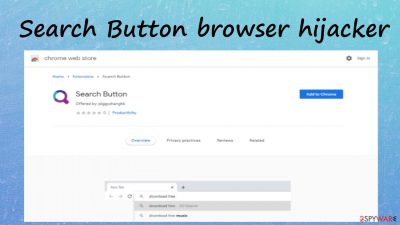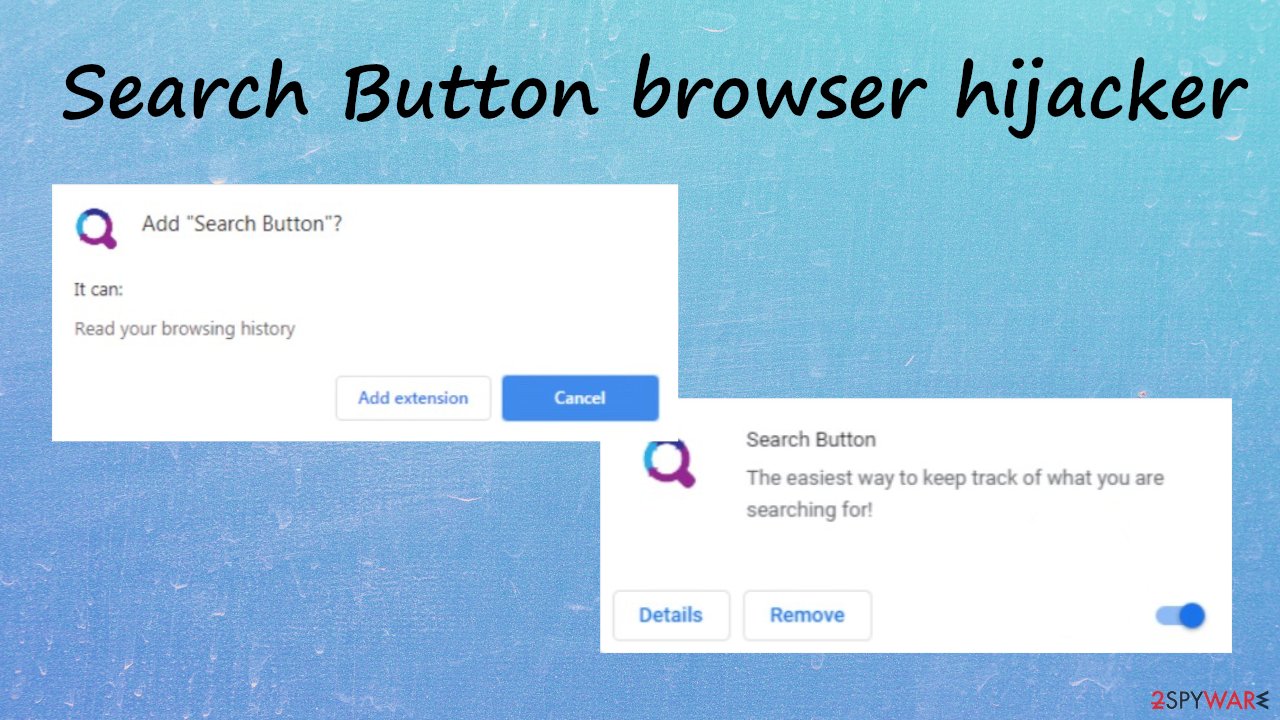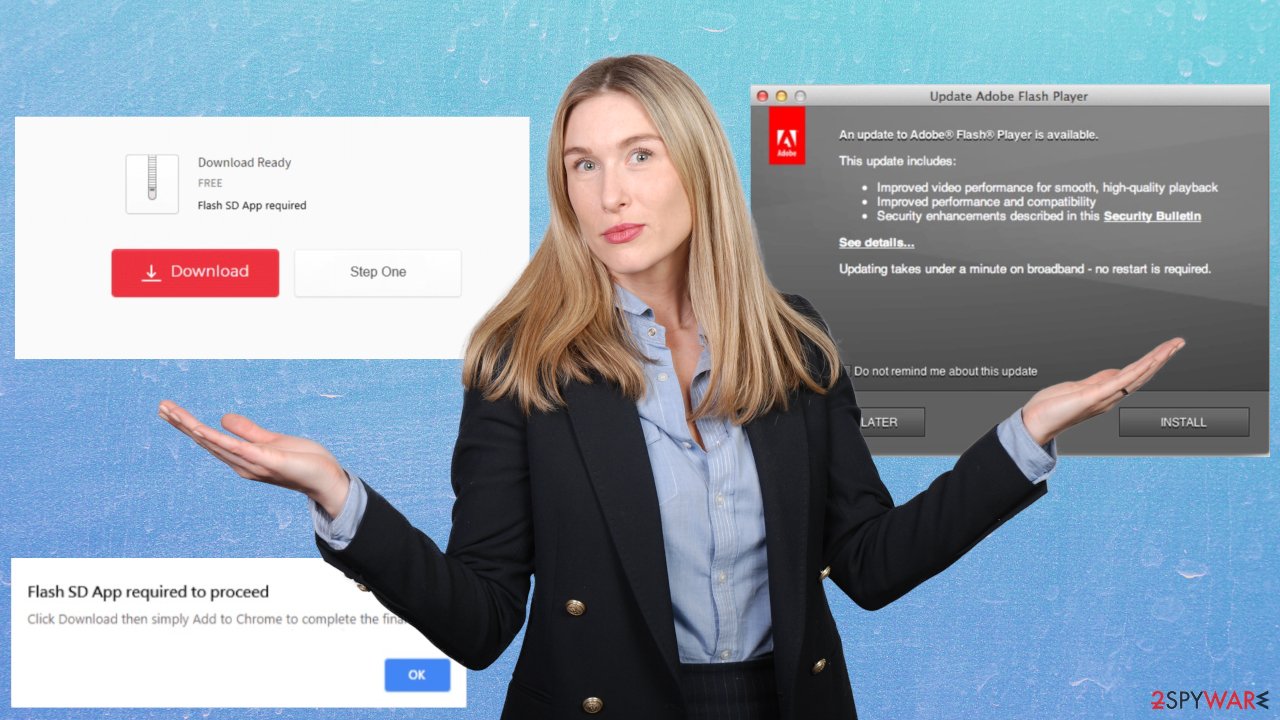Search Button browser hijacker (Free Instructions)
Search Button browser hijacker Removal Guide
What is Search Button browser hijacker?
Search Button browser hijacker – an app that shouldn't be used if you value your privacy and security

Search Button browser hijacker is a potentially unwanted program[1] with all kinds of dangerous traits. First of all, it might change your browser preferences, such as the default search engine, new tab, and homepage. That's done to redirect all search traffic through a website of its choice. During our research, the appointed search engine was keysearchs.com, which is fake as it doesn't generate any search results. But depending on your geolocation, the search engines might differ and some of the sessions go through Bing.com.
Typically, fake search engines redirect to legitimate ones and show their results with a slight twist – advertisements. They could be shown as search results, recommended searches, etc. Usually, displayed ads are deceptive as they have nothing in common with the affiliated sites. They're made to lure you into clicking them by showing various misleading contents.
When Search Button virus is installed on your device either as an app or a browser extension, it can collect various browsing details. That could endanger your privacy and security. This article contains its removal instructions and system recovery options.
| name | Search Button |
|---|---|
| Type | Browser hijacker, PUP, redirect virus |
| Altered browser settings | New tab, default search engine, homepage |
| Promoted fake search site | keysearchs.com |
| IP address | 104.21.36.47 |
| Symptoms | Modified browser settings, search results riddled with ads, slower device performance, redirects to untrustworthy sites |
| Risks | Privacy issues, monetary losses, PUP installation, malware infections |
| Distribution | Software bundling, fake Flash Player updates, deceptive ads, file-sharing platforms |
| Elimination | You can use trustworthy anti-malware software to remove cyber threats from your infected device automatically |
| System repair | PUPs alter system directories which may cause system failures such as crashing, freezing, etc. Run a scan with the all-in-one FortectIntego system diagnostics tool to take care of all system-related issues |
Browser hijacker, unnecessary toolbars, adware,[2] and similar junkware are rarely installed willingly. Typically, people don't know how similar software got on their devices. That's because their developers use sneaky techniques for their distribution. Because of that and their shady functions, they are deemed as potentially unwanted programs (PUPs).
Search Button is a worthless app that should never be installed or used. Although, for a limited time, it was falsely advertised as a useful tool on Google Chrome Web Store, it could also be installed on your device through software bundles, deceptive ads, and other stealthy methods.
The main goal of this browser intruder is to generate internet traffic to its affiliated sites. It does that by causing redirects and displaying ads in search results. Some of the sponsored sites might be harmless, but some might have ill intentions, such as to draw out your private details, infect devices with malware, involve you in various scams, etc.
Furthermore, Search Button browser hijacker is capable of data-tracking. While you're casually browsing, it could collect various non-personal details, including:
- browser and device info,
- addresses of visited sites,
- geolocations,
- used apps,
- IP addresses, etc.

Advertisers usually use this gathered data to present ads irresistible to you. But if it fell into the wrong hands, you could get in trouble. That's why you should never install any similar PUPs. If you think that Search Button might be on your device, please scan your device with reliable security tools such as SpyHunter 5Combo Cleaner or Malwarebytes to remove it.
Then check if it's not installed as a browser extension as well. If you're not sure how that's done, we've included detailed removal guides at the bottom of this article. And lastly, IT experts[3] highly recommend performing system diagnostics with the time-proven FortectIntego system repair tool to automatically take care of all system irregularities.
Avoid malware and PUPs by enhancing your cybersecurity
Threat actors are always searching for new ways to infect innocent people's computers and developing more and more sophisticated malware. Tech giants such as Google, Apple, Microsoft, and others are doing their best to keep up with cybercriminals, but it's a very tough task.
That's why everyone who uses the internet regularly must take care of their security themselves. We, here at 2-spyware.com, have compiled a list of guidelines that will greatly increase your cybersecurity level and make it very hard for any evildoers to bypass it:
- Install the latest updates to your Operating System and all other software (except BETA versions).
- Acquire a professional security tool and make a habit of scanning your system at least twice a week.
- Regularly perform system diagnostics to keep system files and settings at bay.
- Keep backups of all critical data on at least two separate devices/locations, e.g., offline storage, the cloud, etc.
- Learn about the most popular methods cybercriminals use to spread their creations by doing a web search or reading our articles.
- Pay attention when installing any new software. Download it only from verified sources or straight from its developers.

Remove Search Button virus from your device within minutes
Browser hijackers, such as Color Page virus, CoolWebSearch.winproc32 virus, Searchmy.co virus, etc., should never be used. They change browser settings without your direct permission to redirect search traffic, display deceptive ads, collect browsing-related data, increase the popularity of affiliated sites, and so on.
It doesn't matter if you were tricked into installing Search Button browser hijacker by a false advertisement or it got on your system unknowingly – you have to remove it ASAP. The easiest way to do it is to perform a full system scan with a trustworthy security tool.
Sometimes, this PUP could be installed as a browser extension. If that's the case, feel free to use our comprehensive removal guides below. Afterward, repair altered system files and delete tracking cookies by running a system tune-up with proper software so you could enjoy your device anew.
You may remove virus damage with a help of FortectIntego. SpyHunter 5Combo Cleaner and Malwarebytes are recommended to detect potentially unwanted programs and viruses with all their files and registry entries that are related to them.
Getting rid of Search Button browser hijacker. Follow these steps
Uninstall from Windows
Instructions for Windows 10/8 machines:
- Enter Control Panel into Windows search box and hit Enter or click on the search result.
- Under Programs, select Uninstall a program.

- From the list, find the entry of the suspicious program.
- Right-click on the application and select Uninstall.
- If User Account Control shows up, click Yes.
- Wait till uninstallation process is complete and click OK.

If you are Windows 7/XP user, proceed with the following instructions:
- Click on Windows Start > Control Panel located on the right pane (if you are Windows XP user, click on Add/Remove Programs).
- In Control Panel, select Programs > Uninstall a program.

- Pick the unwanted application by clicking on it once.
- At the top, click Uninstall/Change.
- In the confirmation prompt, pick Yes.
- Click OK once the removal process is finished.
Delete from macOS
Remove items from Applications folder:
- From the menu bar, select Go > Applications.
- In the Applications folder, look for all related entries.
- Click on the app and drag it to Trash (or right-click and pick Move to Trash)

To fully remove an unwanted app, you need to access Application Support, LaunchAgents, and LaunchDaemons folders and delete relevant files:
- Select Go > Go to Folder.
- Enter /Library/Application Support and click Go or press Enter.
- In the Application Support folder, look for any dubious entries and then delete them.
- Now enter /Library/LaunchAgents and /Library/LaunchDaemons folders the same way and terminate all the related .plist files.

Remove from Microsoft Edge
Delete unwanted extensions from MS Edge:
- Select Menu (three horizontal dots at the top-right of the browser window) and pick Extensions.
- From the list, pick the extension and click on the Gear icon.
- Click on Uninstall at the bottom.

Clear cookies and other browser data:
- Click on the Menu (three horizontal dots at the top-right of the browser window) and select Privacy & security.
- Under Clear browsing data, pick Choose what to clear.
- Select everything (apart from passwords, although you might want to include Media licenses as well, if applicable) and click on Clear.

Restore new tab and homepage settings:
- Click the menu icon and choose Settings.
- Then find On startup section.
- Click Disable if you found any suspicious domain.
Reset MS Edge if the above steps did not work:
- Press on Ctrl + Shift + Esc to open Task Manager.
- Click on More details arrow at the bottom of the window.
- Select Details tab.
- Now scroll down and locate every entry with Microsoft Edge name in it. Right-click on each of them and select End Task to stop MS Edge from running.

If this solution failed to help you, you need to use an advanced Edge reset method. Note that you need to backup your data before proceeding.
- Find the following folder on your computer: C:\\Users\\%username%\\AppData\\Local\\Packages\\Microsoft.MicrosoftEdge_8wekyb3d8bbwe.
- Press Ctrl + A on your keyboard to select all folders.
- Right-click on them and pick Delete

- Now right-click on the Start button and pick Windows PowerShell (Admin).
- When the new window opens, copy and paste the following command, and then press Enter:
Get-AppXPackage -AllUsers -Name Microsoft.MicrosoftEdge | Foreach {Add-AppxPackage -DisableDevelopmentMode -Register “$($_.InstallLocation)\\AppXManifest.xml” -Verbose

Instructions for Chromium-based Edge
Delete extensions from MS Edge (Chromium):
- Open Edge and click select Settings > Extensions.
- Delete unwanted extensions by clicking Remove.

Clear cache and site data:
- Click on Menu and go to Settings.
- Select Privacy, search and services.
- Under Clear browsing data, pick Choose what to clear.
- Under Time range, pick All time.
- Select Clear now.

Reset Chromium-based MS Edge:
- Click on Menu and select Settings.
- On the left side, pick Reset settings.
- Select Restore settings to their default values.
- Confirm with Reset.

Remove from Mozilla Firefox (FF)
Remove dangerous extensions:
- Open Mozilla Firefox browser and click on the Menu (three horizontal lines at the top-right of the window).
- Select Add-ons.
- In here, select unwanted plugin and click Remove.

Reset the homepage:
- Click three horizontal lines at the top right corner to open the menu.
- Choose Options.
- Under Home options, enter your preferred site that will open every time you newly open the Mozilla Firefox.
Clear cookies and site data:
- Click Menu and pick Settings.
- Go to Privacy & Security section.
- Scroll down to locate Cookies and Site Data.
- Click on Clear Data…
- Select Cookies and Site Data, as well as Cached Web Content and press Clear.

Reset Mozilla Firefox
If clearing the browser as explained above did not help, reset Mozilla Firefox:
- Open Mozilla Firefox browser and click the Menu.
- Go to Help and then choose Troubleshooting Information.

- Under Give Firefox a tune up section, click on Refresh Firefox…
- Once the pop-up shows up, confirm the action by pressing on Refresh Firefox.

Remove from Google Chrome
Delete malicious extensions from Google Chrome:
- Open Google Chrome, click on the Menu (three vertical dots at the top-right corner) and select More tools > Extensions.
- In the newly opened window, you will see all the installed extensions. Uninstall all the suspicious plugins that might be related to the unwanted program by clicking Remove.

Clear cache and web data from Chrome:
- Click on Menu and pick Settings.
- Under Privacy and security, select Clear browsing data.
- Select Browsing history, Cookies and other site data, as well as Cached images and files.
- Click Clear data.

Change your homepage:
- Click menu and choose Settings.
- Look for a suspicious site in the On startup section.
- Click on Open a specific or set of pages and click on three dots to find the Remove option.
Reset Google Chrome:
If the previous methods did not help you, reset Google Chrome to eliminate all the unwanted components:
- Click on Menu and select Settings.
- In the Settings, scroll down and click Advanced.
- Scroll down and locate Reset and clean up section.
- Now click Restore settings to their original defaults.
- Confirm with Reset settings.

Delete from Safari
Remove unwanted extensions from Safari:
- Click Safari > Preferences…
- In the new window, pick Extensions.
- Select the unwanted extension and select Uninstall.

Clear cookies and other website data from Safari:
- Click Safari > Clear History…
- From the drop-down menu under Clear, pick all history.
- Confirm with Clear History.

Reset Safari if the above-mentioned steps did not help you:
- Click Safari > Preferences…
- Go to Advanced tab.
- Tick the Show Develop menu in menu bar.
- From the menu bar, click Develop, and then select Empty Caches.

After uninstalling this potentially unwanted program (PUP) and fixing each of your web browsers, we recommend you to scan your PC system with a reputable anti-spyware. This will help you to get rid of Search Button browser hijacker registry traces and will also identify related parasites or possible malware infections on your computer. For that you can use our top-rated malware remover: FortectIntego, SpyHunter 5Combo Cleaner or Malwarebytes.
How to prevent from getting browser hijacker
Choose a proper web browser and improve your safety with a VPN tool
Online spying has got momentum in recent years and people are getting more and more interested in how to protect their privacy online. One of the basic means to add a layer of security – choose the most private and secure web browser. Although web browsers can't grant full privacy protection and security, some of them are much better at sandboxing, HTTPS upgrading, active content blocking, tracking blocking, phishing protection, and similar privacy-oriented features. However, if you want true anonymity, we suggest you employ a powerful Private Internet Access VPN – it can encrypt all the traffic that comes and goes out of your computer, preventing tracking completely.
Lost your files? Use data recovery software
While some files located on any computer are replaceable or useless, others can be extremely valuable. Family photos, work documents, school projects – these are types of files that we don't want to lose. Unfortunately, there are many ways how unexpected data loss can occur: power cuts, Blue Screen of Death errors, hardware failures, crypto-malware attack, or even accidental deletion.
To ensure that all the files remain intact, you should prepare regular data backups. You can choose cloud-based or physical copies you could restore from later in case of a disaster. If your backups were lost as well or you never bothered to prepare any, Data Recovery Pro can be your only hope to retrieve your invaluable files.
- ^ Potentially unwanted program. Wikipedia. The free encyclopedia.
- ^ Lucian Constantin. What is adware? How it works and how to protect against it. Csoonline. Security news, features and analysis.
- ^ Dieviren. Dieviren. Spyware news and security.























